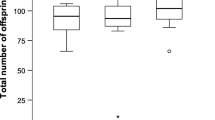Abstract
WhenBoophilus microplus and Type-II hybrids (B. microplus females×B. annulatus males) were released simultaneously onto bovine hosts, mating between the two forms appeared not to be at random. There were more contypic and fewer intertypic matings than predicted under an assumption of panmixia. An examination of the patterns of matings revealed that more of the matings on the first two days of detachment were between the two sexes ofB. microplus. Engorged females dropping on the last four days of maximum female detachment were predominantly hybrids mated to bothB. microplus and hybrid males. The non-random mating pattern does not appear to be caused by assortative mating betweenB. microplus and Type-II hybrids, but because theB. microplus were competnet to mate two days before the hybrids and theB. microplus males compete for mates of both types better than the Type-II males.
Similar content being viewed by others
References
Arthur, D.R. and Londt, J.G.H., 1973. The parasitic cycle ofBoophilus decoloratus (Koch 1844) (Acarina: Ixodidae). J. Entomol. Soc. S. Afr., 36: 87–116.
Davey, R.B., 1986. Mating competitiveness of hybridBoophilus male ticks compared to purestrainB. annulatus andB. microplus males (Acari: Ixodidae). J. Med. Entomol., 23: 433–436.
Davey, R.B. and Cooksey, L.M., 1988. Sex ratios ofBoophilus ticks (Acari:Ixodidae) reaching adulthood on cattle, J. Med. Entomol., 25: 82–84.
Davey, R.B., Garza, J. Jr. and Thompson, G.D., 1982. Seasonal observations on the development and ovipositional capability ofBoophilus annulatus andB. microplus (Acari: Ixodidae) reared on bovines. J. med. Entomol. 19: 24–28.
Davey, R.B., Osburn, R.L., and Castillo, C., 1983. Longevity and mating behavior in males and parthenogenesis in females in hybridizedBoophilus ticks (Acari: Ixodidate). J. Med. Entomol., 20: 614–617.
Graham, O.H. and Price, M.A., 1966, Some morphological variations inBoophilus annulatus microplus (Acarina: Ixodidae) from northern Mexico. Ann. Entomol. Soc. Am., 59: 450–452.
Graham, O.H., Price, M.A. and Trevino, J.L., 1972. Cross-mating experiments withBoophilus annulatus andB. microplus (Acarina: Ixodidae). J. Med. Entomol. 9: 531–537.
Hilburn, L.R., Gunn, S.J. and Davey, R.B., 1990). The genetics of New WorldBoophilus microplus (Canestrini) andB. annulatus (Say) in their possible control. Bull. Soc. Vector Ecol., 14: 222–231.
Londt, J.G.H., and Arthur, D.R., 1975. The structure and parasitic life cycle ofBoophilus microplus (Canestrini, 1888) in South Africa (Acarina: Ixodidae). J. Entomol. Soc. S. Afr. 38: 321–340
Newton, W.H., Price, M.A., Graham, O.H., and Trevino, J.L., 1972. Chromosomal and gonadal aberrations observed in hybrid offspring of MexicalBoophilus annulatus×B.microplus. Ann. Entomol. Soc. Am., 65: 536–541.
Norval, R.A.I. and Sutherst, R.W., 1986. Assortative mating betweenBoophilus decoloratus andBoophilus microplus (Acari: Ixodidae). J. Med. Entomol., 23: 459–460.
Osburn, R.L. and Knipling, E.F., 1982. The potential use, of sterile hybridBoophilus ticks (Acari: Ixodidae) as a supplemental eradication technique. J. Med. Entomol., 19: 637–644
Sattler, P.W., Hilburn, L.R., Davey, R.B., George, J.E. and Rojas Avalos, J.B., 1986. Genetic similarity and variability between natural populations and laboratory colonies of North AmericanBoophilus (Acari: Ixodidae). J. Parasitol., 72: 95–100.
Sokal, R.R. and Rohlf, F.J., 1969. Biometry. Freeman, San Francisco.
Stone, B.F., 1963. Parthenogenesis in the cattle tick,Boophilus microplus. Nature, 200: 1233.
Sutherst, R.W., 1987. The dynamics of hybrid zones between tick (Acari) species. Int. J. Parasitol., 17: 921–926.
Thompson, G.D., Davey, R.B., Osburn, R.L. and Cruz, D., 1980. Longevity and fertilization capacity of males and parthenogenesis in females ofBoophilus annulatus andB. microplus. J. Econ. Entomol., 73: 378–380.
Thompson, G.D., Osburn, R.L., Davey, R.B., Drummond, R.O. and Price, M.A. 1981a. Hybrid sterility in cattle ticks (Acari: Ixodidae). Experientia, 37: 127–128.
Thompson, G.D., Osburn, R.L., Davey, R.B. and Price, M.A., 1981b. The dynamics of hybrid sterility betweenBoophilus annulatus andB. microplus (Acari:Ixodidae) through successive generations. J. Med. Entomol., 18: 413–418.
Weidhaas, D.E., Haile, D.G., George, J.E., Osburn, R.L. and Drummond, R.O., 1983. A basic model for use in computer simulations ofBoophilus tick biology and control. USDA-ARS Adv. Agric. Technol., AAT-S-32/December 1983.
Author information
Authors and Affiliations
Rights and permissions
About this article
Cite this article
Hilburn, L.R., Davey, R.B., George, J.E. et al. Non-random mating betweenBoophilus microplus and hybrids ofB. microplus females andB. annulatus males, and its possible effect on sterile male hybrid control releases. Exp Appl Acarol 11, 23–36 (1991). https://doi.org/10.1007/BF01193726
Accepted:
Issue Date:
DOI: https://doi.org/10.1007/BF01193726




